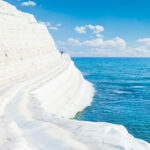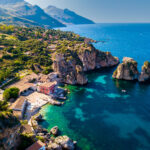World Heritage Site for Baroque architecture, Modica will captivate you with its history, its views and the sweetness of its chocolate
In Sicily you can find historical, cultural and artistic evidence of every era. It often happens to discover cities and towns that have had so many dominations to be stratified, giving visitors glimpses of rare beauty and unusual and surprising cultural encounters.
It is part of this elite Modica, in the province of Ragusa: the city was founded by the Greeks and is now a UNESCO heritage site for its historic center rich in baroque architecture.
Destroyed by an earthquake in 1693, Modica was rebuilt and is now divided into two large neighbourhoods, Modica Alta and Modica Bassa, located on a valley, which was once the bed of a river, surrounded by hills, so much so that the houses were built using the natural cavities of the rock and are leaning against each other, creating the effect of a living crib.
The earthquake started the reconstruction of the late Baroque city but did not completely erase the ancient testimonies: in the heart of the old town there is still the Necropolis of Quartiriccio, archaeological site that preserves the traces of the first human settlement of the city, with 30 tombs carved into the rock that date back more than 2000 years before Christ.
The city is dominated by the Castello dei Conti, which stands on a rock spur that in the past exalted its defensive features. The castle already existed in 1200 while the Torre dell’Orologio was erected in 1300. Inside you can find the ancient medieval prisons while recent recovery works have unearthed the cave of the hundred stairs, a tunnel that leads from the castle to the valley below.
There are other ancient testimonies, such as the rupestral church of San Nicolò inferiore, built between the 11th and 12th centuries, one of the best preserved examples of Byzantine rupestral architecture, built digging in the limestone bank near the riverbed of the stream: Inside you can find the apse with icons in the Byzantine style and the Christ Pantocrator. The Church of the Carmine, among the few to have survived the earthquake, has a portal of 1300 in Gothic-Catalan style and a rose window with 12 rays.

But it is the baroque that has made the city famous. Here, then, in Modica alta, the magnificence of the Cathedral of San Giorgio, with its monumental staircase, to the left of which you can admire Palazzo Polara, late-baroque architecture. The staircase of the cathedral is also enriched by a hanging garden on several levels, called the Orto del Piombo. Behind the Duomo, there is the Palazzo Napolino-Tommasi Rosso. The tour of Modica Alta can not be separated from the visit to the Church and the Convento di Santa Maria del Gesù, which blends the late gothic and baroque and where you can visit a beautiful cloister on two levels, and the Church of San Giovanni Evangelista, also introduced by an imposing staircase.
In Modica Bassa there is the Church of San Pietro (which is often referred to as the Duomo because, together with the Duomo di San Giorgio, it has the title of Chiesa Madre, to witness the duality and rivalry between the two neighbourhoods of Modica), another example of the 18th century hut: in its staircase are the statues of the “Santuni”.
Inside you can find the monumental organ made by the Polizzi brothers consisting of 3200 pipes, 32 registers and 2 keyboards. A few steps away is the simple and elegant Church of Santa Maria del Soccorso, with the Jesuit College.
For lovers of literature you can also visit the Museo Casa natale Salvatore Quasimodo: the poet, born in Modica in 1901, won the Nobel Prize for literature in 1951. A collection of paintings belonging to the hermetic poet can be found in the Palace of Culture, which houses the Civic Museum, where there is l’Eracle di Cafeo, a 22 cm tall statue dating back to the 3rd century B.C. found in 1967 during works along the Irminio river.
Modica owes its fame also to chocolate, the first IGP chocolate in Europe, which is made with a particular cold working process by master chocolatiers modicani, without the phase of conching to preserve the integrity of its ingredients: the result is a chocolate more grainy on the palate, intense and unique flavour. The particular technique of processing cocoa beans was introduced during the Spanish domination in the county of Modica. Chocolate is celebrated every December with the event Chocomodica, a great festival that floods with sweetness all the avenues of the city. For those who could not be in Modica during the event, you can visit the chocolate museum all year round: Inside you can retrace the history of its evolution and then visit two rooms with exposed 22 chocolate sculptures, where you can admire a large “bas-relief” with miniature Italy made entirely of chocolate. There are also sensory workshops and a path to attend the preparation of chocolate with final tasting.

The artistic beauties of Modica can also be admired from some elevated points that offer a fantastic overview to the visitor. Among these the most famous is Pizzo Belvedere, reachable from the stairs that flank the Cathedral of San Giorgio. It is a panoramic terrace overlooking the rooftops of Modica Alta but from which is also visible part of Modica Bassa. Along Via Sant’Andrea you can find the Belvedere San Benedetto, about 1 km from the center. Finally, if you are constantly searching for postcard photos, there is also the Vetta del Monserrato, with a very fascinating view from above. All these viewpoints offer the maximum of the show if reached in the evening, to be conquered by a beautiful sunset or to look at the village illuminated by street lamps, when the effect of “living nativity scene” is realised.
What are you waiting for? Visit Modica, the city will surprise you in every way. Amazing Modica, Amazing Sicily!





Comments are closed.